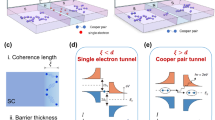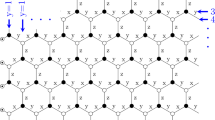Abstract
The Bitter decoration technique is used to study the trapping of single and multiple quanta vortices by a lattice of circular microholes. By keeping a thin superconducting layer (the bottom) inside each hole we are able to visualise the trapped vortices. From this we determine, for the first time, the filling factor FF, i.e. the number of vortices captured inside a hole. In all cases the sample is cooled at a constant field before making the decoration. Two qualitatively different states of the vortex crystal are observed: (i) In case when the interhole distance is much larger than the coherence length, the filling factor averaged over many identical holes (〈(FF〉)) is a stepwise function of the magnetic flux (of the external field) through the hole, because each hole captures the same number of vortices. The density of fluxoids inside the openings is higher than in the uniform film, but much lower than it should be in the state of equilibrium. We claim that the number of trapped vortices is determined by the edge superconducting states which appear around each hole at the modified third critical fieldH c3 * >H c2 . BelowH c2 such states produce a surface barrier of a new type. This barrier for the vortex entrance and exit is due to the strong increase of the order parameter near the hole edge. It keeps constant the number of captured vortices during the cooling at a fixed field, (ii) An increase of the hole density or of the hole radius initiates a sharp redistribution of fluxoids: all of them drop inside holes. This first order transition leads to a localization of all vortices and consequently to a qualitative change of the transport properties (TAFF in our case). In the resulting new state the filling factor is not any more the same for neighbouring holes and its averaged value is equal to the frustration of the hole network.
Similar content being viewed by others
References
G. S. Mkrtchyan and V. V. Shmidt,Soviet Phys. JETP 34, 195 (1972).
B. Khalfin and B. Ya. Shapiro,Physica C 202, 393 (1992).
A. I. Buzdin,Phys. Rev. B 47, 11416 (1993).
L. D. Cooley and A. M. Grishin,Phys. Rev. Lett. 74, 2788 (1995).
A. T. Fiory, A. F. Hebard, and S. Somekh,Appl. Phys. Lett. 32, 73 (1978).
M. Baertet al, Europhysics Letters 29, 157 (1995).
Yu. N. Ovchinnikov,Sov. Phys. JETP 52, 923 (1980).
P. G. De Gennes,Superconductivity of Metals and Alloys, W. A. Benjamin, Inc., New York (1966).
Yu. N. Ovchinnikov,Sov. Phys. JETP 52, 755 (1980).
A. Bezryadin and B. Pannetier,J. of Low Temp. Phys. 98, 251 (1995).
D. Saint-James and P. G. de Gennes,Phys. Lett. 7, 306 (1963).
H. J. Fink,Phys. Rev. Lett. 14, 309 (1965).
B. Pannetier, J. Chaussy, and R. Rammal,Phys. Rev. Lett. 53, 1845 (1984); B. Pannetier,in Quantum Coherence in Mesoscopic Systems, Plenum, New York, 1991.
K. Runge and B. Pannetier,Europhys. Lett. 24, 737 (1993).
A. Bezryadin, Yu. N. Ovchinnikov, and B. Pannetier, to appear inPhys. Rev. B.
K. Runge, Ph.D. Thesis, Joseph Fourier University, Grenoble (1993).
A. Bezryadin, A. Buzdin, and B. Pannetier,Phys. Rev. B 51, 3718 (1995).
The coherence length atT = T c3 * ifn ∼ 1 is approximately equal to the hole radius: ζ ∼R. See the phase diagram for a single hole in Ref. 18.
L. Landau and E. Lifshitz,Statistical Physics (Pergamon Press, London, 1979).
M. Tinkham,Introduction to Superconductivity (McGraw-Hill, New York, 1975), Chap. 4-10.2, p. 135.
A. Bezryadin, A. Buzdin, and B. Pannetier, to appear in proceedings “Macroscopic Quantum Phenomena and Coherence in Superconducting Networks,” 2–5 March 1995, Frascati, Italy.
M. Tinkham,Introduction to Superconductivity (McGraw-Hill, New York), Chap. 5-7.1, p. 175; P. M. Keset al., Supercond. Sci. Technol. 1, 242 (1989).
S. P. Benzet al, Phys. Rev. B 38, 2869 (1988).
M. Baertet al, Phys. Rev. Lett.74, 3269 (1995)
Author information
Authors and Affiliations
Additional information
We are very grateful to O. Buisson, A. Buzdin, A. Eichenherger, J. L. Genicon, B. Grebenschikov, A. Neminskii, and Yu. N. Ovchinnikov for many useful discussions, to M. Ferlet for help in the decoration, and to D. A. Lisachenko for the careful reading of the manuscript. The work is supported by the CEE “SUPNET” contract ERBCGRCT920068.
Rights and permissions
About this article
Cite this article
Bezryadin, A., Pannetier, B. Role of edge superconducting states in trapping of multi-quanta vortices by microholes. Application of the bitter decoration technique. J Low Temp Phys 102, 73–94 (1996). https://doi.org/10.1007/BF00755110
Received:
Revised:
Issue Date:
DOI: https://doi.org/10.1007/BF00755110




